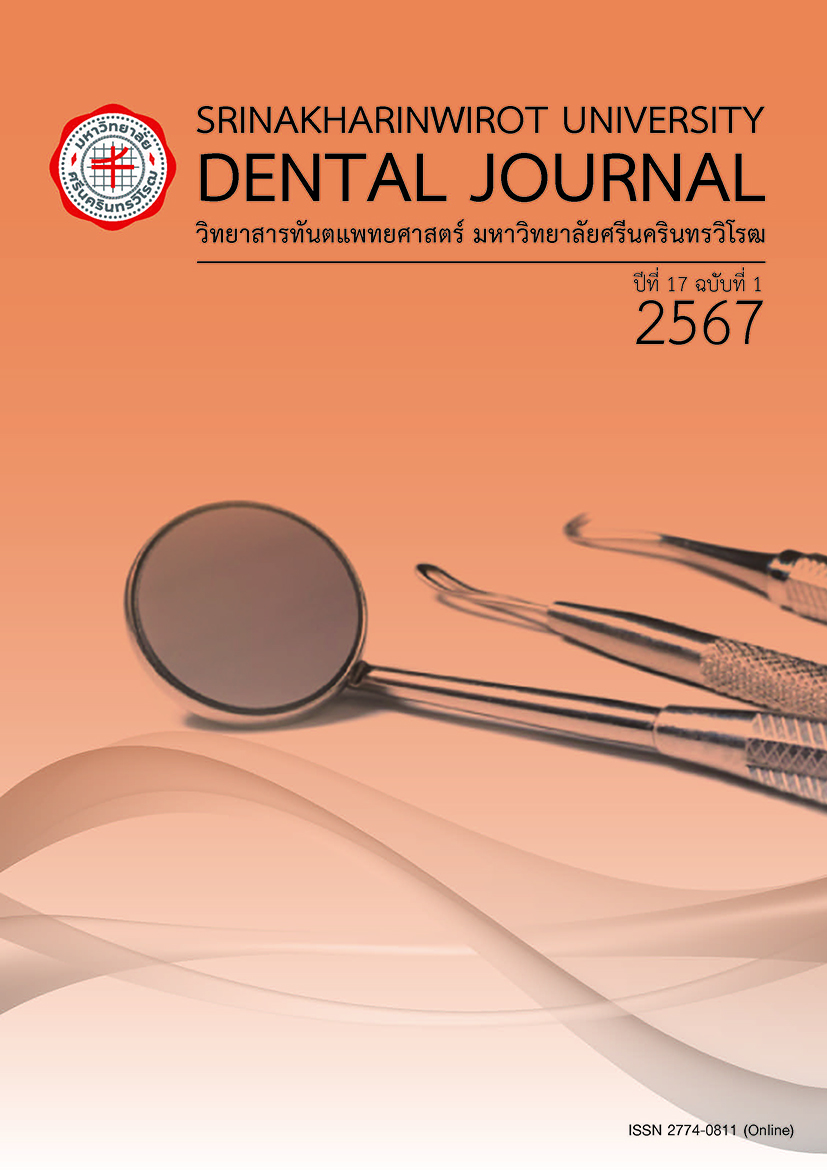ผลของการแปรงลิ้นต่อการลดลงของไอระเหยสารประกอบซัลเฟอร์
The Effect of Tongue Brushing on Reduction of Volatile sulfur compounds
Keywords:
ไอระเหยสารประกอบซัลเฟอร์, กลิ่นปาก, การแปรงลิ้น, volatile sulfur compounds, oral malodor, tongue brushingAbstract
วัตถุประสงค์: เพื่อศึกษาการเปลี่ยนแปลงของระดับไอระเหยสารประกอบซัลเฟอร์ (ไฮโดรเจนซัลไฟด์ เมธิลเมอร์แคปแทน และไดเมธิลซัลไฟด์) ภายหลังการแปรงลิ้นร่วมกับการแปรงฟันและใช้ไหมขัดฟัน โดยติดตามผล 2 สัปดาห์ วัสดุอุปกรณ์และวิธีการ: กลุ่มตัวอย่างที่ไม่มีโรคประจำตัว จำนวน 30 ราย ได้รับการตรวจวัดระดับไอระเหยสารประกอบซัลเฟอร์ด้วยเครื่องวัดระดับก๊าซยี่ห้อออรัลโครมาวัน ก่อนเริ่มทำการแปรงลิ้น จากนั้นแบ่งเป็นสองกลุ่ม กลุ่มควบคุมให้แปรงฟันและใช้ไหมขัดฟันปกติทุกวัน กลุ่มทดลองให้แปรงลิ้นร่วมกับการแปรงฟันและใช้ไหมขัดฟัน เมื่อครบ 2 สัปดาห์ จึงมาวัดระดับไอระเหยสารประกอบซัลเฟอร์และเปรียบเทียบก่อนและหลังการแปรงลิ้นด้วยวิธีทางสถิติโดยใช้อินดิเพนเดนท์ ที เทสท์ ที่ระดับความเชื่อมั่นร้อยละ 95 (p < 0.05) ผลการศึกษา: กลุ่มทดลองที่ได้รับการแนะนำการแปรงลิ้นร่วมกับการแปรงฟันและใช้ไหมขัดฟัน มีระดับไอระเหยสารประกอบซัลเฟอร์ทั้งสามชนิด ลดลงจากระดับเริ่มต้นอย่างมีนัยสำคัญทางสถิติ แตกต่างจากกลุ่มที่ไม่ได้รับการแปรงลิ้น เมื่อเทียบที่ระยะเวลา 2 สัปดาห์ สรุป: การแปรงลิ้นร่วมกับการแปรงฟันและใช้ไหมขัดฟันช่วยลดระดับไอระเหยสารประกอบซัลเฟอร์ซึ่งเป็นก๊าซที่ก่อให้เกิดกลิ่นปากได้ เมื่อวัดที่ระยะเวลา 2 สัปดาห์ Objective: To study the difference in volatile sulfur compounds levels (hydrogen sulfide, methyl mercaptan and dimethyl sulfide) between baseline and after tongue brushing together with brushing and flossing at a 2-week follow up. Materials and methods: Thirty healthy subjects were tested for volatile sulfur compounds levels using Oral chroma I as baseline. The subjects were then divided into two groups. The control group brushed and flossed their teeth everyday. The test group used tongue scraper together with brushing and flossing. After 2 weeks, the levels of volatile sulfur compounds were then measured and compared with baseline by a statistical method (Independent T test) at a 95% confident level (p < 0.05). Results: The test group with tongue scraper had a statistical significance in reducing of volatile sulfur compounds when compared to baseline while the volatile sulfur compounds level in control group was not statistical different from the baseline at 2 weeks. Conclusions: Tongue brushing, along with tooth brushing and flossing, reduced volatile sulfur compounds levels after brushing for 2 weeks.Downloads
References
Bosy A. Oral malodor: philosophical and practical aspects. J Can Dent Assoc. 1997;63(3):196-201.
Zurcher A, Laine ML, Filippi A. Diagnosis, Prevalence, and Treatment of Halitosis. Curr Oral Health Rep. 2014;1(4):279-285.
Loesche WJ, Kazor C. Microbiology and treatment of halitosis. Periodontol 2000. 2002;28:256-79.
Nakano, Y, Yoshimura M, Koga T. Correlation between oral malodor and periodontal bacteria. Microbes Infect. 2002;4(6):679-83.
John M, Vandana KL. Detection and measurement of oral malodor in periodontitis patients. Indian J Dent Res. 2006;17(1):2-6.
Van Den Broek AM, Feenstra L, de Baat C. A review of the current literature on management of halitosis. Oral Dis. 2008;14(1):30-9.
Rosenberg M. Clinical assessment of bad breath: current concepts. J Am Dent Assoc. 1996;127(4):475–81.
Yaegaki K, Coil JM. Genuine halitosis, pseudo-halitosis, and halitophobia: classification, diagnosis, and treatment. Compend Contin Educ Dent. 2000;21(10A):880-6.
Romano, F, Pigella E, Guzzi N, AimettiM. Patients self-assessment of oral malodour and its relationship with organoleptic scores and oral conditions. Int J Dent Hyg. 2010;8(1):41-6.
Sara B, Giuseppe M, Adelaide CM. Dorsal Lingual Surface and Halitosis: a Morphological Point of View. Acta Stomatol Croat. 2016;50(2):151-7.
Danser MM, Gomez SM, Weijden GA. Tongue coating and tongue brushing: a literature review. Int J Dent Hyg. 2003;1(3):151-8.
Haas AN, Silveira EM, Rösing CK. Effect of tongue cleansing on morning oral malodour in periodontally healthy individuals. Oral Health Prev Dent. 2007;5(2):89-94.
Outhouse TL, Al-Alawi R, Fedorowicz Z, Keenan JV. Tongue scraping for treating halitosis. Cochrane Database Syst Rev. 2006;19(2):CD005519. doi: 10.1002/14651858.CD005519.pub2.
Keceli TI, Gulmez D, Dolgun A, Tekcicek M. The relationship between tongue brushing and halitosis in children. A randomized controlled trial. Oral Dis. 2013;21(1): 66-73. 15. Chen C, Jin YS. Effect of mechanical tongue cleaning on halitosis : A meta-analysis. TMR Integr Nurs. 2018; 2(2): 68-75.
Quirynen M, Avontroodt P, Soers C, Zhao H, Pauwels M, Van Steenberghe D. Impact of tongue cleansers on microbial load and taste. J Clin Periodontol. 2004;31(7):506-10.
Choi HN, Cho YS, Koo JW. The effect of mechanical tongue cleaning on oral malodor and tongue coating. Int J Environ Res Public Health. 2022;19(1):108. doi: 10.3390/ijerph19010108.
Kazor CE, Mitchell PM, Lee AM, Stokes LN, Loesche WJ, Dewhirst FE, et al. Diversity of bacterial populations on the tongue dorsa of patients with halitosis and healthy patients. J Clin Microbiol. 2003;41(2):558-63.
Oho T, Yoshida Y, Shimazaki Y, Yamashita Y, Koga T. Characteristics of patients complaining of halitosis and the usefulness of gas chromatography for diagnosing halitosis. Oral Surg Oral Med Oral Pathol Oral Radiol Endod. 2001;91(5):531-4.
Suzuki N, Yoneda M, Naito T, Iwamoto T, Hirofuji T. Relationship between halitosis and psychologic status. Oral Surg Oral Med Oral Pathol Oral Radiol Endod. 2008;106(4):542-7.
Bolepalli AC, Munireddy C, Peruka S, Polepalle T, Choudary Alluri LS, Mishaeel S. Determining the association between oral malodor and periodontal disease: a case control study. J Int Soc Prev Community Dent. 2015;5(5):413-8.
Nandlal B, Shahikumar P, Avinash BS, Sreenivasan PK, Subramanyam R. Malodor reductions and improved oral hygiene by toothbrushing and mouthrinsing. Indian J Dent Res. 2016;27(1):42-7.
Pedrazzi V, Sato S, de Mattos MG, Lara EH, Panzeri H. Tongue-cleaning methods: A comparative clinical trial employing a toothbrush and a tongue scraper. J Periodontol. 2004;75(7):1009-12.
Downloads
Published
How to Cite
Issue
Section
Categories
License
Copyright (c) 2024 Srinakharinwirot University Dental Journal (E-ISSN 2774-0811)

This work is licensed under a Creative Commons Attribution-NonCommercial-NoDerivatives 4.0 International License.
เจ้าของบทความต้องมอบลิขสิทธิ์ในการตีพิมพ์แก่วิทยาสาร โดยเขียนเป็นลายลักษณ์อักษรแนบมาพร้อมบทความที่ส่งมาตีพิมพ์ ตามแบบฟอร์ม "The cover letter format" รวมทั้งต้องมีลายมือชื่อของผู้เขียนทุกท่านรับรองว่าบทความดังกล่าวส่งมาตีพิมพ์ที่วิทยาสารนี้แห่งเดียวเท่านั้น




